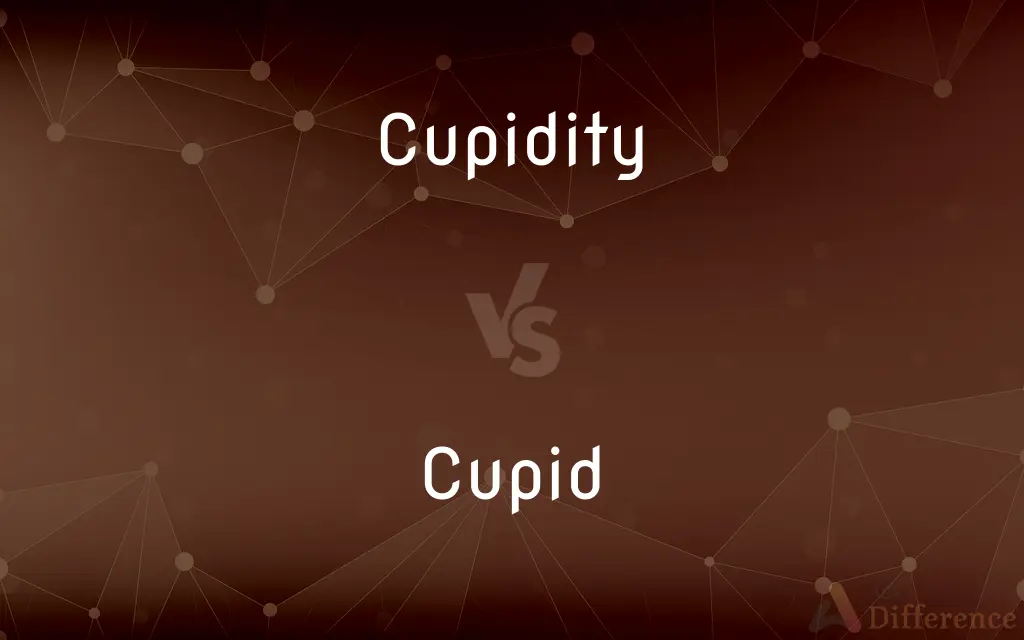Cupidity vs. Cupid — What's the Difference?
By Tayyaba Rehman & Fiza Rafique — Updated on April 16, 2024
Cupidity refers to excessive desire for wealth or possessions, while Cupid is the Roman god of love, often depicted as a winged child with a bow and arrows.

Difference Between Cupidity and Cupid
Table of Contents
ADVERTISEMENT
Key Differences
Cupidity is driven by an intense and often unethical desire for material gain or wealth. Whereas Cupid, in mythology, represents an ethereal figure associated with romantic love, aiming to connect people's hearts.
Cupidity can manifest in behaviors driven by greed and avarice, influencing individuals to act selfishly or unethically to accumulate more wealth. On the other hand, Cupid is often portrayed as a benevolent and playful deity who uses his arrows to cause people to fall in love, typically acting with a lighter, more whimsical intent.
While cupidity can lead to social and personal conflicts due to its materialistic nature, Cupid’s actions, although sometimes capricious, generally aim to foster connections and affection between individuals.
In literature and culture, cupidity is often criticized and depicted as a negative trait that corrupts and complicates lives. Conversely, Cupid is celebrated in stories and art, symbolizing love and the joyous complexities it brings to life.
Cupidity’s influence is tied to the tangible and earthly, closely linked with the pursuit of financial success and possession. Cupid’s realm, however, is the intangible and emotional, focusing on feelings, relationships, and the spiritual aspects of love.
ADVERTISEMENT
Comparison Chart
Definition
Excessive desire for wealth
Roman god of love
Symbolism
Greed, materialism
Love, affection, romantic connection
Typical Representation
Negative, harmful
Positive, often whimsical and playful
Impact on Behavior
Selfish, unethical actions
Inspires love, sometimes irrational acts
Cultural Interpretation
Generally negative
Mostly positive, romanticized
Compare with Definitions
Cupidity
Avaricious ambition.
Her cupidity knew no bounds, as she sought to control the entire industry.
Cupid
Symbol of romantic love.
Valentine’s Day cards frequently feature Cupid with his bow and arrow.
Cupidity
Excessive acquisitiveness.
The executive's cupidity was evident in his lavish lifestyle.
Cupid
Iconic character in literature and art.
Cupid appears as a central figure in many Renaissance paintings.
Cupidity
Intense desire for wealth.
His cupidity led him to betray his closest friends for financial gain.
Cupid
Mythological figure with arrows that inspire love.
According to legend, being struck by Cupid's arrow makes one fall in love instantly.
Cupidity
Greed for money or possessions.
The scandal was fueled by pure cupidity.
Cupid
Roman god of love.
Artists often depict Cupid as a cherubic boy with wings.
Cupidity
Overwhelming materialistic drive.
Cupidity blinded him to the more important things in life.
Cupid
Emblem of affection and desire.
The couple's mutual affection seemed as if Cupid had played a role.
Cupidity
Excessive desire, especially for wealth; covetousness or avarice.
Cupid
In classical mythology, Cupid (Latin Cupīdō [kʊˈpiːdoː], meaning "passionate desire") is the god of desire, erotic love, attraction and affection. He is often portrayed as the son of the love goddess Venus and the god of war Mars.
Cupidity
Extreme greed, especially for wealth.
Cupid
Roman Mythology The god of love; the son of Venus.
Cupidity
A passionate desire; love.
Cupid
Cupid A representation of Cupid as a naked cherubic boy usually having wings and holding a bow and arrow, used as a symbol of love.
Cupidity
Eager or inordinate desire, especially for wealth; greed of gain; avarice; covetousness
With the feelings of political distrust were mingled those of cupidity and envy, as the Spaniard saw the fairest provinces of the south still in the hands of the accursed race of Ishmael.
Cupid
A putto carrying a bow and arrow, representing Cupid or love.
Cupidity
Extreme greed for material wealth
Cupid
Any of various lycaenid butterflies of the genera Chilades, Cupido and Everes.
Cupid
The god of love, son of Venus; usually represented as a naked, winged boy with bow and arrow.
Pretty dimpled boys, like smiling cupids.
Cupid
(Roman mythology) god of love; counterpart of Greek Eros
Common Curiosities
What does Cupid symbolize?
Cupid symbolizes love and romantic desire, often using his arrows to cause people to fall in love.
How does cupidity affect behavior?
Cupidity can lead to unethical or selfish behavior as individuals pursue wealth at the expense of others.
Is Cupid always portrayed positively?
Mostly, yes, though sometimes Cupid's actions can cause chaos or unintended consequences in myths.
Who is Cupid?
Cupid is the Roman god of love, often depicted as a child with wings and a bow and arrows.
What are typical representations of cupidity in culture?
Cupidity is often portrayed as a negative force, leading to corruption and moral decay.
What is the difference between cupidity and ambition?
Cupidity is a negative form of ambition focused solely on material gain, whereas ambition can be a broader, more positive drive towards various goals.
How do societies view cupidity?
Societies generally view cupidity negatively because it emphasizes excessive greed.
What are the consequences of being struck by Cupid’s arrow?
Being struck by Cupid's arrow typically leads to sudden and intense love or attraction.
How is Cupid represented in art?
Cupid is commonly shown as a playful, winged child armed with a bow and arrows.
What is cupidity?
Cupidity refers to a greedy desire for money or possessions.
Can cupidity have positive effects?
Typically, cupidity is viewed negatively as it focuses on excessive material desire.
What lessons can be learned from the differences between cupidity and Cupid?
The differences highlight the contrast between material greed and the enriching, albeit sometimes chaotic, nature of love.
Does Cupid represent anything other than romantic love?
Primarily, Cupid is associated with romantic love, though he sometimes represents the naivety or whimsy of love.
Is cupidity a common theme in literature?
Yes, cupidity is a common theme, often used to illustrate the moral pitfalls of greed.
How has Cupid influenced modern culture?
Cupid continues to influence modern culture, especially around romantic celebrations like Valentine's Day.
Share Your Discovery

Previous Comparison
Drunk vs. Inebriated
Next Comparison
Rib vs. FlangeAuthor Spotlight
Written by
Tayyaba RehmanTayyaba Rehman is a distinguished writer, currently serving as a primary contributor to askdifference.com. As a researcher in semantics and etymology, Tayyaba's passion for the complexity of languages and their distinctions has found a perfect home on the platform. Tayyaba delves into the intricacies of language, distinguishing between commonly confused words and phrases, thereby providing clarity for readers worldwide.
Co-written by
Fiza RafiqueFiza Rafique is a skilled content writer at AskDifference.com, where she meticulously refines and enhances written pieces. Drawing from her vast editorial expertise, Fiza ensures clarity, accuracy, and precision in every article. Passionate about language, she continually seeks to elevate the quality of content for readers worldwide.
















































